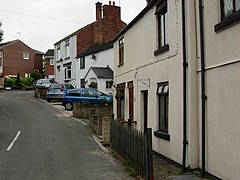Heage
This article needs additional citations for verification. (August 2009) |
| Heage | |
|---|---|
 Baker's Hill | |
| Population | 5,013 (Heage and Ambergate Ward of Ripley Town Council) |
| OS grid reference | SK369505 |
| Civil parish | |
| District | |
| Shire county | |
| Region | |
| Country | England |
| Sovereign state | United Kingdom |
| Post town | BELPER |
| Postcode district | DE56 |
| Dialling code | 01773 |
| Police | Derbyshire |
| Fire | Derbyshire |
| Ambulance | East Midlands |
| UK Parliament | |

The village of Heage in Derbyshire is situated midway between Belper and Ripley and is today famous for its recently restored six-sailed windmill. The village is part of the Heage and Ambergate ward of the Amber Valley District Council. The population of this ward at the 2011 Census was 5,013.[1] Work on building the mill started in 1791 and it was first recorded as working in 1797. The tower is built from local sandstone and after its recent renovation it is now back in working order.
In 1817, the Lysons recorded that "Heage, alias High-edge, lies about five miles from Duffield, upon the road from Chesterfield to Derby. The manor, which had been parcel of the Earldom and Duchy of Lancaster, was granted, with Duffield, to Ditchfield and others. In 1629 it was conveyed to the Stanhope family. Sir William Stanhope bequeathed it, in 1703, to Godfrey Wentworth, Esq. his nephew, whose son of the same name sold it, in 1767, to Francis Hurt, Esq., grandfather of Francis Hurt, Esq., of Alderwasley, who is the present proprietor."[2]
Also located in Heage, at Morley Park, are the remains of two coke-fired blast furnaces for the smelting of iron, built by Francis Hurt of Alderwasley. The first, built in 1780 was the earliest in Derbyshire. The other was built in 1818 and they represent very early coke-fired blast furnaces. They closed in 1874, and most of the site has returned to nature, but the furnace towers still exist and can be seen next to the A38.
The present school was built about 1862 to replace two much smaller schools that were managed by the Church and the Storer Charity. Later it became a secondary school and is now an infants and primary school. The original old Victorian buildings still form part of the school and the old Church school and Charity school are located nearby. When the school was a secondary school it received pupils from three other schools, The Green school (now demolished), Ridgeway school, which has been converted to a house and Ambergate school that is still an infants and junior school. There are a number of recent housing developments in the village.
There are also many jitties (alleyways) in Heage that lead to unexpected places, many originating from the large recreation ground.
Heage has two bus services, the 6.2 and 6.3, both of which are operated by TrentBarton. These link the village to the nearby towns of Ripley and Belper, as well as the City of Derby. The bus services for most of the surrounding primary and secondary schools are provided by the Albert Wilde bus company, which is a relatively small enterprise based in Heage.
The first mention of a post office in Heage was in 1847; the village, however, no longer has a post office. The last one, in premises adjoining the "Windmill" pub, closed in January 2008.
Heage is also home to St. Luke's Church, situated on Church Street. It was originally built in 1646. In 1836 the church was enlarged, this created an unusual 'T' shape which is a rarity in Derbyshire. Services are held every Sunday, varying in traditional and contemporary styles.
References
- ^ "Amber Valley District Council ward 2011". Neighbourhood Statistics. Office for National Statistics. Retrieved 26 March 2011.
- ^ 'Parishes: Doveridge - Duffield', Magna Britannia: volume 5: Derbyshire (1817), pp. 129-142. URL: http://www.british-history.ac.uk/report.aspx?compid=50727. Date accessed: 27 August 2008.
